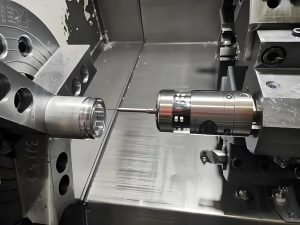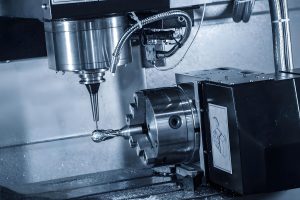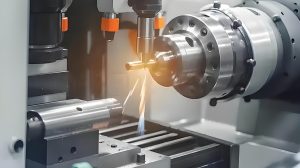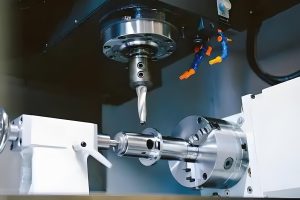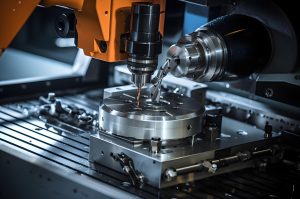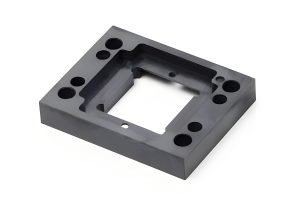Introduction
In the ever – evolving landscape of modern manufacturing, Precision CNC Machining has emerged as a cornerstone technology. It serves as the bridge between innovative design concepts and the production of high – quality, precise parts.
Precision CNC Machining combines the power of computer – numerical control (CNC) with advanced machining techniques. This allows manufacturers to create parts with an accuracy that was once thought to be unattainable. Whether it’s the tiny components in a smartphone or the large, complex parts in an aircraft engine, Precision CNC Machining plays a crucial role in ensuring their quality and functionality.
As industries continue to demand products with higher performance, greater reliability, and more complex geometries, the importance of Precision CNC Machining only grows. In this article, we’ll explore the ins and outs of Precision CNC Machining, from its basic principles to its applications in various industries, and how it can help you achieve perfect parts for your projects.
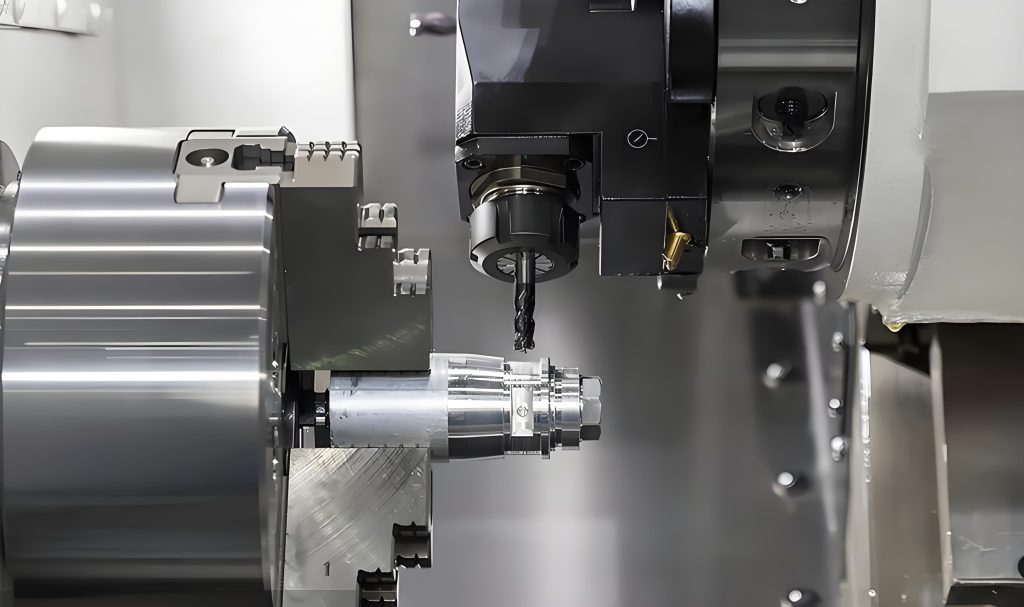
Understanding Precision CNC Machining
What is Precision CNC Machining?
Precision CNC Machining, short for Precision Computer Numerical Control Machining, is a highly advanced manufacturing process. It involves the use of computer – controlled machine tools to remove material from a workpiece with extreme accuracy.
At its core, the CNC system plays a crucial role. It operates based on pre – programmed instructions. These instructions are typically created using computer – aided design (CAD) and computer – aided manufacturing (CAM) software. For example, a designer first creates a 3D model of the part in CAD software. Then, the CAM software converts this 3D model into a set of numerical commands that the CNC machine can understand.
The CNC machine then interprets these commands to precisely control the movement of the cutting tools. This could include linear and rotational movements along multiple axes, such as the X, Y, and Z axes in a 3 – axis machining center. The machine can perform various machining operations like milling, turning, drilling, and grinding. Each operation is carried out with the utmost precision, often achieving tolerances in the micron range. For instance, in a high – end Precision CNC Machining process, it’s possible to achieve a tolerance of ±0.001 mm, which is far beyond what traditional machining methods can typically achieve.
The Significance of Precision in Machining
Precision in machining is of utmost importance as it directly impacts the quality and performance of the final parts. In the automotive industry, for example, engine components like pistons and crankshafts need to be machined with extreme precision. A piston that is not machined to the correct dimensions can lead to issues such as poor engine performance, increased fuel consumption, and even engine failure. Precise machining ensures a proper fit within the engine cylinders, allowing for efficient combustion and smooth operation.
In the aerospace industry, the significance of precision is even more critical. Aircraft components, such as turbine blades in jet engines, must withstand extreme temperatures, high rotational speeds, and significant mechanical stresses. If these blades are not machined precisely, they could experience premature failure during flight, which could have catastrophic consequences. High – precision machining ensures that the blades have the correct aerodynamic shape and dimensions, enabling them to operate efficiently and safely under these harsh conditions.
Moreover, in the medical device industry, precision machining is essential for manufacturing components like surgical instruments and implants. A surgical instrument that is not precisely machined may not function properly during a surgical procedure, potentially endangering the patient’s life. Implants, such as hip or knee replacements, need to be machined to fit perfectly within the patient’s body, promoting proper healing and long – term functionality.
In short, precision machining is not just about making parts that look good; it’s about creating components that perform optimally, ensuring the safety, reliability, and efficiency of the products in which they are used.
The Process of Precision CNC Machining
Step – by – Step Breakdown
- Design and CAD Modeling
- The journey of Precision CNC Machining begins with the design phase. Designers use computer – aided design (CAD) software to create a 3D model of the part. This model serves as the virtual blueprint for the entire machining process. For example, in the design of a custom – made mechanical component for a robotics application, the CAD model will detail every feature, from the smallest hole to the most complex surface curvature. The CAD software allows designers to experiment with different shapes, sizes, and materials virtually, making it easier to optimize the design before moving to the next step.
- CAM Programming
- Once the CAD model is complete, the next step is computer – aided manufacturing (CAM) programming. CAM software takes the 3D CAD model and converts it into a set of instructions that the CNC machine can understand. These instructions, often in the form of G – codes and M – codes, define the movement of the cutting tools, spindle speeds, feed rates, and other machining parameters. For instance, if the part requires milling operations, the CAM program will specify the path the milling cutter should follow to remove material from the workpiece to achieve the desired shape.
- Material Preparation
- Selecting the right material is crucial for the success of the machining process. Common materials used in Precision CNC Machining include metals like aluminum, steel, titanium, and plastics such as acrylic and nylon. The material is usually obtained in the form of bars, blocks, or sheets. Before machining, the material needs to be properly prepared. This may involve cutting the raw material to a suitable size, ensuring its surface is clean and free from contaminants, and sometimes heat – treating it to achieve the desired mechanical properties. For example, in aerospace applications, titanium alloys often need to be pre – heat – treated to enhance their strength and workability before being machined into aircraft components.
- Machine Setup
- The CNC machine is then set up according to the requirements of the job. This includes installing the appropriate cutting tools in the tool holder. Different machining operations require different types of tools. For example, a drilling operation needs a drill bit, while a milling operation may require end mills of various sizes and geometries. The workpiece is securely fastened to the machine’s worktable using fixtures such as vices, clamps, or magnetic chucks. The machine’s axes are also calibrated to ensure accurate movement. This calibration process involves checking and adjusting the position of the machine’s axes to ensure that they move precisely as commanded by the CNC program.
- Machining Operation
- With the machine set up and the program loaded, the actual machining process begins. The CNC machine follows the pre – programmed instructions to perform operations such as milling, turning, drilling, or grinding. In a milling operation, the rotating milling cutter removes material from the workpiece to create features like slots, pockets, and complex 3D surfaces. Turning operations are used to create cylindrical parts, where the workpiece rotates while the cutting tool removes material from the outer surface. Drilling operations create holes in the workpiece, and grinding operations are used to achieve high – precision surface finishes or to remove small amounts of material for tight tolerances. The machine can perform multiple operations in sequence, often without the need for manual intervention, thanks to its automated tool – changing capabilities.
- Quality Inspection
- Throughout the machining process and after the part is completed, quality inspection is carried out. This involves using various measuring and inspection tools. Coordinate measuring machines (CMMs) are commonly used to measure the dimensions of the part accurately. They can measure the length, width, height, and the position of features on the part with high precision. Optical measuring devices, such as laser scanners, can also be used to create a 3D scan of the part and compare it to the original CAD model. Surface roughness testers are used to measure the smoothness of the part’s surface. Any deviations from the specified tolerances are identified, and corrective actions may be taken, such as further machining or adjusting the machining parameters for future production runs.
Key Factors Affecting Precision
- Machine Tool Accuracy
- The accuracy of the CNC machine itself is fundamental to achieving precision machining. High – quality machine tools are designed with advanced features to minimize errors. For example, the linear guides on a CNC milling machine should have low friction and high rigidity to ensure smooth and accurate movement along the X, Y, and Z axes. The spindle, which holds the cutting tool, must have high rotational accuracy. A spindle with excessive run – out (the deviation of the axis of rotation from the ideal axis) can cause inaccuracies in the machined parts, leading to uneven surface finishes and incorrect dimensions. Regular calibration and maintenance of the machine tool are essential to keep it in optimal working condition. This includes checking and adjusting the alignment of the axes, replacing worn – out components, and ensuring that the lubrication system is functioning properly.
- Tool Selection and Wear
- The choice of cutting tools plays a significant role in precision machining. Different materials and machining operations require specific types of tools. For instance, when machining hardened steel, carbide – tipped tools are often preferred due to their high hardness and wear resistance. However, over time, cutting tools experience wear. As the tool wears, its cutting edge becomes dull, which can affect the accuracy of the machining process. Tool wear can lead to increased cutting forces, causing the workpiece to deflect and resulting in dimensional errors. To mitigate this, tool monitoring systems can be used to detect tool wear in real – time. When the tool reaches a certain level of wear, it can be replaced automatically or manually to ensure consistent machining accuracy.
- Cutting Parameters
- Cutting parameters, such as spindle speed, feed rate, and depth of cut, have a direct impact on the precision of the machining process. Spindle speed determines how fast the cutting tool rotates. If the spindle speed is too high, it can cause excessive heat generation, leading to tool wear and dimensional changes in the workpiece due to thermal expansion. On the other hand, if the spindle speed is too low, the cutting process may be inefficient, and the surface finish of the part may be compromised. The feed rate, which is the speed at which the workpiece moves relative to the cutting tool, also needs to be carefully adjusted. A too – high feed rate can cause the tool to chip or break, while a too – low feed rate can result in excessive tool wear and longer machining times. The depth of cut, which is the amount of material removed in each pass of the cutting tool, should be optimized to balance machining efficiency and precision. Incorrect depth of cut can lead to uneven material removal and inaccuracies in the final dimensions of the part.
- Operator Skill and Training
- The skill and experience of the machine operator are also crucial factors. A well – trained operator can set up the machine correctly, select the appropriate cutting parameters, and troubleshoot any issues that may arise during the machining process. They can also interpret the CAD/CAM programs accurately and make adjustments if necessary. For example, an experienced operator may be able to detect subtle changes in the machining process, such as abnormal vibrations or sounds, which could indicate a problem with the tool or the machine. They can then take immediate action to prevent further damage to the workpiece or the machine and ensure that the final part meets the required precision standards. Regular training and professional development for operators are essential to keep up with the latest advancements in Precision CNC Machining technology.
The Value of Rapidefficient in the CNC Machining Market
Efficiency and Speed
Rapidefficient stands out in the CNC machining market for its remarkable efficiency and speed. By leveraging the latest in CNC technology, Rapidefficient can significantly shorten the production cycle. For example, their state – of – the – art CNC machines are equipped with high – speed spindles that can reach rotational speeds much faster than standard machines. This allows for quicker material removal during operations such as milling and turning.
Moreover, Rapidefficient has optimized its machining processes. They use advanced CAM software that can generate highly efficient tool paths. These tool paths are designed to minimize the time spent on non – productive movements, such as retracting the tool and positioning it for the next cut. In a typical production run, this optimization can reduce machining time by up to 30% compared to less – optimized processes. This not only enables faster delivery of products but also allows businesses to take on more projects within a given time frame, increasing their overall productivity.
Quality Assurance
When it comes to quality assurance, Rapidefficient has several key measures in place. First, they use high – precision machine tools. These machines are calibrated regularly to ensure that they maintain their accuracy over time. For instance, their coordinate measuring machines (CMMs) are used to check the accuracy of machined parts at multiple stages of the production process. If any deviation from the specified tolerances is detected, the machining process can be adjusted immediately.
Rapidefficient also has a strict quality control system for its cutting tools. They only use high – quality cutting tools from reputable manufacturers and monitor tool wear closely. As mentioned earlier, tool wear can significantly affect the precision of the machining process. By using advanced tool – monitoring systems, Rapidefficient can detect when a tool is reaching the end of its useful life and replace it promptly. This ensures that every part produced meets the highest standards of precision and quality consistency.
Cost – effectiveness
One of the major advantages of choosing Rapidefficient is its cost – effectiveness. Firstly, by reducing the production cycle and improving machining efficiency, Rapidefficient helps businesses save on labor costs. With faster production times, fewer man – hours are required to complete a project, which directly cuts down on labor expenses.
Secondly, Rapidefficient focuses on minimizing waste. Their advanced machining techniques and precise tool paths result in a high material utilization rate. For example, in the machining of aluminum parts, they can achieve a material utilization rate of over 85%, which is much higher than the industry average. This means that less material is wasted during the machining process, reducing the overall cost of raw materials.
In addition, the low rate of defective parts produced by Rapidefficient also contributes to cost savings. Since their quality control measures are so stringent, the number of parts that need to be re – machined or scrapped due to defects is minimal. This saves businesses the cost of re – work and the loss of materials associated with defective products. Overall, Rapidefficient’s approach to CNC machining can lead to significant cost savings for businesses in the long run.
Applications of Precision CNC Machining
Precision CNC Machining has found its way into a wide range of industries, playing a pivotal role in their development and growth.
Automotive Industry
In the automotive industry, Precision CNC Machining is essential for manufacturing high – performance engine components. For example, cylinder heads, which are complex parts with multiple holes and passages for fuel intake, exhaust, and coolant flow, are precisely machined using CNC technology. The precise machining of these components ensures proper combustion, reduces emissions, and improves fuel efficiency.
Transmission components like gears are also manufactured with the help of Precision CNC Machining. Gears need to have extremely accurate tooth profiles and tolerances to ensure smooth power transfer and minimize noise and vibration. A slight deviation in the gear’s dimensions can lead to premature wear, reduced efficiency, and even transmission failure. With Precision CNC Machining, automotive manufacturers can produce gears with the precision required to meet the high – performance demands of modern vehicles.
Aerospace Industry
The aerospace industry relies heavily on Precision CNC Machining for the production of critical components. Turbine blades in jet engines are one of the most demanding applications. These blades are designed to operate in extremely harsh environments, with high temperatures, high rotational speeds, and significant mechanical stresses. Precision CNC Machining allows for the creation of blades with complex aerodynamic shapes and tight tolerances. For instance, the airfoil shape of a turbine blade is precisely machined to optimize the flow of hot gases, maximizing engine efficiency.
Aircraft structural components, such as wing spars and fuselage frames, also require high – precision machining. These components need to be lightweight yet extremely strong to ensure the safety and performance of the aircraft. Precision CNC Machining enables the use of advanced materials like titanium and high – strength aluminum alloys, and the precise shaping of these materials to meet the exacting design requirements of aerospace engineers.
Medical Device Industry
In the medical device industry, Precision CNC Machining is used to manufacture a wide range of products, from surgical instruments to implants. Surgical instruments, such as scalpels, forceps, and drills, need to be precisely machined to ensure their functionality and safety during surgical procedures. For example, a drill bit used in orthopedic surgery must have a precise tip shape and diameter to accurately create holes in bones without causing damage to surrounding tissues.
Implants, like hip and knee replacements, are another area where Precision CNC Machining is crucial. These implants need to be a perfect fit for the patient’s body. They are machined to match the patient’s unique anatomy, which is often determined through medical imaging techniques such as CT scans. The high – precision machining ensures that the implants integrate well with the patient’s natural bone, reducing the risk of complications and improving the long – term success of the implant.
Electronic Device Industry
The electronic device industry benefits greatly from Precision CNC Machining, especially in the production of components for smartphones, tablets, and laptops. Small, intricate parts such as connectors, heat sinks, and housings are precisely machined. For example, the connectors in a smartphone need to be machined with extreme precision to ensure a reliable electrical connection. A misaligned or poorly – machined connector can lead to issues such as signal loss or intermittent charging problems.
Heat sinks, which are used to dissipate heat generated by electronic components, are also produced using Precision CNC Machining. These heat sinks often have complex fin structures that are precisely machined to maximize heat dissipation efficiency. The tight tolerances achieved through CNC machining ensure that the heat sinks fit perfectly with the electronic components they are designed to cool.
Challenges and Solutions in Precision CNC Machining
Common Challenges
- Complex Shape Machining Difficulties
As the demand for parts with complex geometries increases, machining such shapes becomes a significant challenge. For example, in the aerospace industry, parts like impellers have intricate curved surfaces and multiple blades. These complex shapes require precise programming and advanced machining strategies. The traditional machining methods often struggle to achieve the required accuracy when dealing with such complex geometries. Programming errors can easily occur, leading to incorrect tool paths that may result in under – or over – machining of the workpiece.
- Tool Wear
Cutting tools are constantly in contact with the workpiece during machining, which leads to inevitable wear. High – speed machining operations, in particular, generate a large amount of heat and mechanical stress on the tool. For instance, when machining hard materials like titanium alloys, the cutting edge of the tool can quickly wear out due to the high hardness and poor thermal conductivity of the material. As the tool wears, its cutting performance deteriorates. The cutting forces increase, which can cause vibrations in the machining process. These vibrations not only affect the surface finish of the part but also lead to dimensional inaccuracies.
- Thermal Deformation
During Precision CNC Machining, heat is generated due to the friction between the cutting tool and the workpiece, as well as the energy consumed in the material – removal process. This heat can cause the workpiece and the machine components to expand thermally. In high – speed machining, the temperature rise can be significant. For example, in a high – speed milling operation of a large aluminum workpiece, the temperature of the cutting zone can reach several hundred degrees Celsius. The thermal expansion of the workpiece can cause dimensional changes, and if not properly compensated for, the final dimensions of the part will deviate from the design specifications. Moreover, the thermal expansion of the machine tool components, such as the spindle and the linear guides, can also affect the accuracy of the machining process.
Innovative Solutions
- Advanced Machining Processes
New machining processes have been developed to address the challenges of complex shape machining. Multi – axis machining, such as 5 – axis machining, has become increasingly popular. In a 5 – axis machining center, the workpiece can be rotated and tilted in multiple directions while being machined. This allows the cutting tool to access complex surfaces from different angles, reducing the need for multiple set – ups and improving the accuracy of the machining. For example, when machining an impeller, a 5 – axis machine can create the complex blade shapes in a single operation, achieving higher precision and better surface quality compared to traditional 3 – axis machining.
Hybrid machining processes, which combine different machining methods, are also emerging as a solution. For instance, the combination of additive manufacturing and subtractive machining (such as CNC machining) can be used to create parts with complex internal structures. First, the additive manufacturing process is used to build the basic shape of the part, including the complex internal features. Then, CNC machining is employed to finish – machine the outer surfaces and achieve the required tolerances.
- Advanced Tool Materials
To combat tool wear, advanced tool materials have been developed. Nanocomposite tool materials, for example, offer enhanced wear resistance and toughness. These materials are composed of nanoparticles embedded in a matrix material, which can improve the overall performance of the tool. Coated tools are also widely used. Tools coated with materials like titanium nitride (TiN), titanium carbide (TiC), or diamond – like carbon (DLC) have a longer tool life. The coating reduces the friction between the tool and the workpiece, minimizing heat generation and wear. For machining hard and abrasive materials, cubic boron nitride (CBN) tools are often used. CBN has a high hardness, second only to diamond, and excellent thermal stability, making it suitable for high – speed machining of hard steels and other difficult – to – machine materials.
- Intelligent Monitoring Systems
Intelligent monitoring systems are being increasingly used to address the issue of thermal deformation and other machining – related problems. These systems use sensors to monitor various parameters during the machining process, such as temperature, vibration, cutting forces, and tool wear. For example, thermal sensors can be installed on the workpiece and the machine tool components to monitor the temperature in real – time. Based on the temperature data, the machining parameters can be adjusted automatically to compensate for thermal expansion. Vibration sensors can detect any abnormal vibrations during machining. If vibrations are detected, the system can either adjust the cutting parameters, such as reducing the feed rate or spindle speed, or stop the machining process to prevent damage to the workpiece and the tool. Tool – monitoring sensors can detect the wear of the cutting tool. When the tool reaches a certain level of wear, the system can prompt the operator to replace the tool or automatically change the tool in a machining center with an automatic tool – changing system.
Future Trends in Precision CNC Machining
Technological Advancements
- Artificial Intelligence and Machine Learning Integration
- In the future, artificial intelligence (AI) and machine learning (ML) will play an increasingly significant role in Precision CNC Machining. AI – powered systems can analyze vast amounts of data from the machining process in real – time. For example, they can monitor factors such as cutting forces, temperature, and vibration. Based on this analysis, the AI system can automatically adjust machining parameters like spindle speed, feed rate, and depth of cut to optimize the process. This not only improves the efficiency of the machining but also enhances the quality of the parts produced. In a manufacturing plant that produces a large number of complex parts, an AI – integrated CNC machine can learn from previous machining operations and make intelligent decisions to reduce errors and improve production throughput.
- ML algorithms can be used to predict tool wear and machine failures. By analyzing historical data on tool usage, material types, and machining conditions, the ML model can forecast when a cutting tool is likely to wear out or when a machine component might fail. This allows manufacturers to schedule maintenance proactively, reducing unplanned downtime and increasing the overall productivity of the manufacturing process.
- Big Data Analytics
- The use of big data analytics in Precision CNC Machining will continue to grow. During the machining process, a large amount of data is generated, including information about the workpiece, the cutting tools, and the machine’s performance. Big data analytics can help in making sense of this data. For instance, by analyzing data from multiple machining runs, manufacturers can identify patterns and trends. They can determine the optimal machining parameters for different materials and part geometries. This knowledge can then be used to improve the quality and efficiency of future production runs. In a large – scale automotive manufacturing facility, big data analytics can be used to analyze the machining data of thousands of engine components. This analysis can lead to the discovery of ways to reduce machining time and improve the precision of the components, ultimately saving costs and improving the quality of the final products.
- Big data can also be used for quality control. By continuously monitoring the machining process data, any deviations from the normal operating conditions can be quickly detected. This enables manufacturers to take corrective actions immediately, reducing the number of defective parts produced.
- 5G Technology Application
- 5G technology will bring significant changes to Precision CNC Machining. Its high – speed, low – latency, and high – reliability characteristics enable real – time data transmission between CNC machines, robots, and other manufacturing equipment. For example, in a smart factory setting, 5G can be used to remotely control CNC machines. Operators can monitor and adjust the machining process from a remote location, which is especially useful in situations where direct access to the machine is difficult or dangerous.
- 5G also facilitates the implementation of the Internet of Things (IoT) in the manufacturing environment. CNC machines can be connected to a network of sensors, other machines, and management systems. This connectivity allows for seamless communication and data sharing. For instance, a CNC machine can communicate with a 3D scanner in real – time. The 3D scanner can provide up – to – date information about the workpiece’s geometry, and the CNC machine can adjust its machining operations accordingly to ensure the highest level of precision.
Industry Developments
- Green Manufacturing
- As environmental concerns become more prominent, the trend towards green manufacturing in the Precision CNC Machining industry is on the rise. Manufacturers are focusing on reducing energy consumption during the machining process. For example, they are developing more energy – efficient CNC machines with advanced servo – drive systems that consume less power. Additionally, the use of sustainable materials in machining is becoming more common. In the aerospace industry, instead of using traditional high – energy – consuming materials, new composite materials are being explored for use in aircraft components. These materials not only reduce the weight of the components but also require less energy to machine.
- Waste reduction is another important aspect of green manufacturing. Precision CNC Machining techniques are being refined to minimize material waste. By optimizing the tool paths and using advanced machining strategies, manufacturers can increase the material utilization rate, reducing the amount of scrap generated during the production process.
- Customization and Small – Batch Production
- The demand for customized products is growing across various industries. Precision CNC Machining is well – positioned to meet this demand. With the help of advanced CAD/CAM software, manufacturers can quickly design and produce customized parts. For example, in the medical device industry, customized implants can be produced based on the patient’s unique anatomy. The CAD model of the implant is created using medical imaging data, and then the CNC machine precisely manufactures the implant according to the design.
- Small – batch production is also becoming more prevalent. Instead of producing large quantities of identical parts, many companies are now producing smaller batches of parts with different specifications. Precision CNC Machining allows for quick change – overs between different part designs, making it suitable for small – batch production. This flexibility enables companies to respond more quickly to market demands and reduce inventory costs.
- Industry Chain Integration
- In the future, there will be more integration within the Precision CNC Machining industry chain. Upstream suppliers of raw materials and components, such as those providing high – quality metals and advanced cutting tools, will collaborate more closely with CNC machine manufacturers and downstream manufacturers in industries like automotive and aerospace. For example, a raw material supplier may work with a CNC machine manufacturer to develop new materials that are easier to machine and have better performance characteristics. This collaboration can lead to the development of more efficient machining processes and higher – quality end – products.
- Integrating different stages of the manufacturing process, from design to production and assembly, will also become more common. For instance, a company that designs and manufactures complex mechanical parts may integrate its design department with its CNC machining and assembly operations. This integration can streamline the production process, reduce communication barriers, and improve overall efficiency.
In conclusion, if you are looking for a reliable partner for CNC aluminum processing, Rapidefficient is an excellent choice. With its high – efficiency, strict quality assurance, and cost – effective solutions, Rapidefficient can meet your various needs in the field of Precision CNC Machining. Whether you need small – batch or large – scale production, Rapidefficient has the capabilities and expertise to deliver high – quality aluminum parts with precision and speed.
Conclusion
In summary, Precision CNC Machining is an indispensable technology in modern manufacturing. Its ability to produce parts with high precision and complex geometries has enabled the development of advanced products across various industries, from high – performance cars to life – saving medical devices.
The process of Precision CNC Machining, from design and programming to material selection and quality inspection, is a complex yet highly rewarding one. It requires a combination of advanced technology, skilled operators, and continuous innovation to overcome challenges such as complex shape machining, tool wear, and thermal deformation.
Rapidefficient, with its focus on efficiency, quality, and cost – effectiveness, has carved a niche for itself in the highly competitive CNC machining market. Their state – of – the – art technology, optimized processes, and strict quality control measures make them a reliable partner for businesses looking to produce high – quality parts. Whether it’s reducing production times, ensuring consistent quality, or minimizing costs, Rapidefficient offers solutions that can give your projects a competitive edge.
As we look to the future, the integration of AI, big data, and 5G technology in Precision CNC Machining holds great promise. These technological advancements, along with industry trends towards green manufacturing, customization, and industry chain integration, will continue to reshape the landscape of Precision CNC Machining. By staying informed and embracing these changes, manufacturers can position themselves for success in this ever – evolving field.
Recommendation for Rapidefficient CNC Aluminum Processing Service Providers
In conclusion, if you are looking for a reliable partner for CNC aluminum processing, Rapidefficient is an excellent choice. With its high – efficiency, strict quality assurance, and cost – effective solutions, Rapidefficient can meet your various needs in the field of Precision CNC Machining. Whether you need small – batch or large – scale production, Rapidefficient has the capabilities and expertise to deliver high – quality aluminum parts with precision and speed.
Rapidefficient strictly enforces ISO quality standards and has obtained the ISO 90001:2015 Certification. This means their production lines use advanced technology to ensure manufacturing precision and accuracy. They also have in – house advanced measurement and testing equipment, which can verify that all materials and parts meet your specifications.
Moreover, Rapidefficient has strong R&D capabilities. Besides its own R&D team, it can unite hundreds of top – level electronic R&D companies, software development firms, materials science institutions, and industrial design suppliers across China, Japan, and other parts of Asia. This enables them to bring more innovative ideas and solutions to your projects.
The ordering process with Rapidefficient is straightforward. First, you can get an instant quote by converting your PDF, CAD (dwg, dxf) file format 2D or STP, IGS, XT file format 3D designs and attaching them to their Quotation page. You will receive quote feedback within the fastest 6 hours. Then, they will analyze your design and confirm tolerances, material, part surface finish, price, delivery time, and other specifications with you. Next, their own manufacturing facilities will bring your designs to life, and your design will undergo strict quality inspection before delivery. Finally, you just need to wait for the delivery. If you wish, they will regularly send you the packaging and delivery process, and they always welcome your questions.
So, if you want to ensure the success of your CNC aluminum processing projects, don’t hesitate to contact Rapidefficient.

